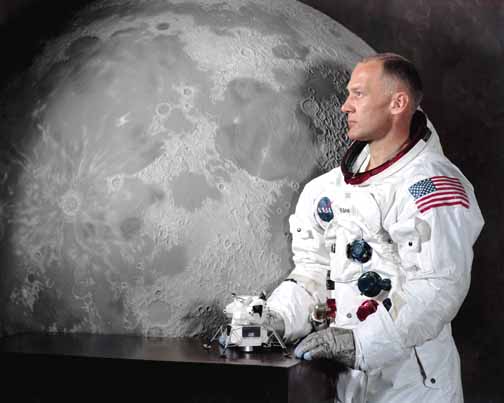July 20, 1969—a day that would go down in history, as the first humans went on to set foot on the Moon. With an estimated 530 million people worldwide watching at the time, today’s generation can recall their parents or grandparents describe the chills they felt as Neil Armstrong spoke his famous words.1 People today tend to forget that there was a second man to touch down some fifteen minutes after Armstrong: Edwin “Buzz” Aldrin, a man sometimes forgotten simply because he was not the first man on the Moon, on a mission that could have been quite capably another NASA tragedy.
The Apollo 11 Mission consisted of a crew of three men; Apollo 11 Commander Neil Armstrong, Command Module Pilot Michael Collins, and Lunar Module Pilot Edwin “Buzz” Armstrong.2 On July 16, 1969, the crew prepared to launch from Cape Kennedy in Florida. Aldrin described what he saw, as his colleagues were being strapped into the rocket. He took in the moment and the magnitude of the journey the crew was about to embark on:

“As far as I could see there were people and cars lining the beaches and highways. The surf was just beginning to rise out of an azure-blue ocean. I could see the massiveness of the Saturn V rocket below and the magnificent precision of Apollo above. I savored the wait and marked the minutes in my mind as something I would always want to remember.”3
At 9:32 a.m. on July 16, 1969, the Saturn V Rocket ignited, launching the crew of Apollo 11 towards the Moon some 238,900 miles away. Aldrin poetically describes his view of Earth from space, “The thought reoccurred that wars are generally fought for territory or are disputes over borders; from space the arbitrary borders established on Earth cannot be seen.”4
On July 20, with the ever growing Moon in sight, the Lunar Module detached from the Command Module. From here on out, Aldrin was the pilot. It was his turn to etch his name in the history of humankind.
While advancing toward the Moon’s surface, the dreaded yellow caution light came on. Being so far away from Earth, yet so close to the surface of the Moon, the astronauts’ only hope was that the malfunction wasn’t critical. “Hearts shot up into throats while we waited to learn what would happen.”5 The crew received another caution warning before being told by their flight commander back in Houston to proceed. Following the first two warnings, Aldrin and Armstrong went on to receive at least three more warnings before being reassured, once again, that the mission was still a go.
July 20, 1969 at 4:17 p.m. — Edwin “Buzz” Aldrin successfully lands Lunar Module Eagle on the surface of the Moon in Mare Tranquillitatis (The Sea of Tranquility). Command Center has been painfully waiting four long days to hear Aldrin radio the words of success: “Houston, Tranquility Base here. The Eagle has landed.”6

Edwin “Buzz” Aldrin became the second man to set a pair of footprints on the surface of the Moon some fifteen minutes after his Command Leader Neil Armstrong initially touched down. When asked about the Moon’s scenery, Aldrin described it as “Beautiful, beautiful. Magnificent Desolation.”7 The crew spent the following hours taking samples from the Moon, taking photos, and of course, planting the American Flag on the Moon’s surface.
Twenty-one hours after landing, it was time to head back to Earth. The Eagle would meet back up with the Command Module Columbia and its pilot Michael Collins in the Moon’s orbit. The crew shared a brief celebratory moment before preparing their return voyage—back towards Earth’s orbit. The crew would return to Earth eight days after launch, landing in the Pacific Ocean on July 24, 1969.8 In a stunning display of American science Buzz Armstrong, along with the rest of the Apollo 11 crew, ultimately ended the Space Race—heeding President John F Kennedy’s 1961 call to put American men on the Moon and safely return them before the decade’s end.

“And, therefore, as we set sail we ask God’s blessing on the most hazardous and dangerous and greatest adventure on which man has ever embarked.” — John F. Kennedy, September 12, 1962
- Sarah Loff, “Apollo 11 Mission Overview,” NASA, April 17, 2015. http://www.nasa.gov/mission_pages/apollo/missions/apollo11.html. ↵
- Lawrence W. Baker, Sarah Hermsen, Rob Nagel, Peggi Saari, Space Exploration Reference Library (Detriot; UXL, 2008), 178. ↵
- Edgar M. Cortright, Apollo Expeditions to the Moon: The NASA History (Courier Corporation, 2012), 204. ↵
- Edgar M. Cortright, Apollo Expeditions to the Moon: The NASA History (Courier Corporation, 2012), 206. ↵
- Edgar M. Cortright, Apollo Expeditions to the Moon: The NASA History (Courier Corporation, 2012), 212. ↵
- NASA Content Administrator, “July 20, 1969: One Giant Leap For Mankind.” NASA, February 19, 2015, http://www.nasa.gov/mission_pages/apollo/apollo11.html. ↵
- Buzz Aldrin and Wayne Warga, Return to Earth (Open Road Media, 2015), ebook. ↵
- Buzz Aldrin and Wayne Warga, Return to Earth (Open Road Media, 2015), ebook. ↵



97 comments
William Rittenhouse
This was such an incredible step for mankind. It still is. The United States is still the only country to ever put a man on the moon and China and Russia have made soft landings on the moon. The future of space exploration is exciting and much more is to be learned. Mars is the next step and compainies claim they can do it before 2032. One good thing about Trump being president is that he has increased NASA’s overall budget intended specifically for deep space exploration. We are living in exciting times.
Pedro Gonzalez Aboyte
Whenever I hear people talk about the moon landing, I always put Neil Armstrong and Buzz Aldrin together but I realize that not many people knew about Buzz. It is very interesting to learn about the Apollo 11 mission from a different point of view. The entire mission would not have been possible if Buzz, along with the other two astronauts did what they were supposed to do. We must give much credit to, not only, Armstrong but Aldrin and Collins as well.
Maisie Favila
This article was really interesting, especially learning more about Edwin “Buzz” Aldrin. Although I knew about the Apollo 11 Mission, I wasn’t really aware of some things. I found the fact that there were a handful of warnings before they had officially landed. Although part of me is skeptical about NASA and space exploration, I enjoyed learning about it and getting ideas of what happened. Overall, this article was well written and very informative.
Lamont Traylor
I have a lot of respect for NASA and the entire space program in general. I find it very empowering and inspiring to see humans that think and proactively try to advance the human race as a whole. A lot of people believe that their technological advancements are “wrong” because they are trying to be god, but at the same time those same people will sit back and enjoy the benefits of the explorations.
Julia Deais
This is a well written article. I did not know that Edwin “Buzz” Aldrin was the second man man to walk on the moon. It is surprising to me how he followed Neil Armstrong fifteen minutes after the first steps but did not really get any recognition even though they were together. I do not understand why people could not say that they both did it instead of one person getting most of the credit and recognition.
Daniela Duran
I can’t even imagine how beautiful desolated and simply admirable the moon must be! I feel it is quite unfair that Buzz is not often given the recognition he deserves for what he did in his visit to the moon. Perhaps nothing would have been possible without him and I therefore think that this article did a great job in reminding us that he deserves acknowledgement for his accomplishments! It was great to read about how they had to deal with three warnings, and still had the courage to continue with the mission! It was simply great!
Alexandria Zapata
People easily forget about Buzz Aldrin, and just remember Neil Armstrong, who was the first man on the moon, and capped the oh so famous phrase “one small step for man, one giant leap for mankind”. It’s interesting to read their trip to the moon in the point of view as on of the astronauts. Aldrin was actually the pilot, and landed Lunar Module Eagle on the moon, successfully.
Cooper Dubrule
Many people believe that Buzz Aldrin’s legacy is overshadowed by the legacy of Neil Armstrong and arguably one might say that much of the credit for the first mission to the moon and all we gained from that is misplaced to Armstrong as well. This article does very well at showing how Buzz contributed to the missions and his importance in the larger scope of things.
Daniela Cardona
I never knew that was any possible problems with the moon landing. It is sad that Buzz does not get as much attention as Neil does, but I do have to admit it makes sense. Neil was the captain, first of all. Second of all, everyone patiently waited to see the FIRST steps on the moon. After Neil took them, I am sure everyone began to party and celebrate subsequently turned away from the TV missing Buzz. At the end of the day, whether he gets as much hype or not, he still walked on the moon and not many people can say they did that.
Sabrina Hsu
I really liked that this article focused more on Buzz Aldrin and not just on Neil Armstrong. This tends to happen a lot in situations like this, where everyone only gives credit to one person and not everyone who was involved. I think no matter what, anyone who is able to do something as successful and historical as landing on the moon should be recognized. It’s something that only several people have done and is such an amazing thing.